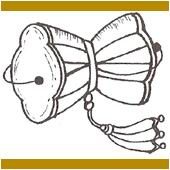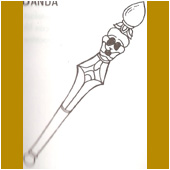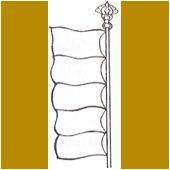
D
Daiji
Originally Chinese, it is called Yin-Yang, which represents the female and male or the negative and positive energy. The union symbolizes a balanced proportion of the yin (negative) and the yang (positive) forces in nature.
The dots in each nucleus stand for the permutation in life: with the white dot expanding to entirely remove the darkness or the shadow in life, and with the black dot expanding to eventually remove the bright side of life.
In Buddhism it is called Daiji, which represents the cycle of rebirth – samsara – and Nirvana, the state of peace.
In Tibetan Buddhism it is called Yub-yam. In Tantra it represent the yunganaddha position: the sexual embrace or total union of opposites, the male and female, or of wisdom and creative energy.

Damaru
Among the Hindus this is on attribute of Shiva as Nataraj, the Dancing Shiva. Apparently he dances only when he is angry. Among the Buddhists it serves as a ritual rattle.

Danda
This is usually a stick or a baton, but is regarded there as a scepter. As a ritual artifact it is made of human bone decorated with a skull and a ratna, which is placed there as a knob. It symbolizes dominance.

Deva
A god of undetermined rank. There are said to be thirty-three in number, eleven
for each of the three worlds of Buddhist cosmology.
Devata
A female deity in Cambodian art.
Devi, devi
A goddess of undetermined rank. The shakti or consort of Shiva, and a goddess
with many forms. Her mild forms are Uma (light). Sati (the virtuous one), Annapuran
(the bestower of good deeds), Haimavati (born of the Himalayas), Jagamata (mother
of the world), and Bhavani (the female creator). Her terrible forms are Durga
(inaccessible), Kali (black), Shyama (balck), chandi (fierce), and Bhairavi
(terrible).
Dhama, dharma
Law, truth, reality, or righteousness. In Theravada Buddhism, it refers to the
teachings of the Buddha as found in the Tripitaka.
Dhar-djuk
This is the Tibetan prayer flag. Like the prayer wheel (mane), it is an indigenous concept and distinctly identifies Tibetan establishment.
It is made up of five colors: blue (nan-ngun)at the top end representing the sky; white (tinaka-davos) for the clouds; red (farhmath) for the atmosphere; yellow (shazu) for the sun and green (tshu-jhang) for the earth, these colors are interchangeable in position and there can be more emphasis on one or two colors. These colors are also associated with the five dhyani Buddhas.
The prayers( parshing) are actually etched on wooden planks, then inked with the cloth pressed on them to the print the prayers. The cloth is usually hung on a flagpole, but could also be hung horizontally on a rooftop and often shrouded with a white shawl called katakhi, -important for marriages rituals and the dead.
Prayer flags are replaced annually during the Tibetan New Year in February. There are also different banners for deities and other purposes.

Dharmachakra
The Wheel of the Law, a symbol of the Buddha's first sermon. The wheel also
symbolizes the setting in motion of the Buddha's philosophy. In sculpture, the
wheel is often depicted with a pair of deer because the Buddha's first sermon
was preached in the Deer Park at Sarnath in North India.
Dharmachakramudra
A head gesture of a Buddha image setting in motion the Wheel of the Law, symbolizing
the reaching of the Buddha. Both hands are held out at chest level. The right
hand is palm out, the left hand palm in, with forefingers and thumbs forming
two circles. The circles of the two hands either touch or interlock.
Dikpala
Guardian of one of the four cardinal points, or the four directions of the sky,
who protects the world from demons. Dikpalas are often depicted on Hindu temples
facing in different directions there are eight listed dikpalas who guard the
four main and four intermediate direction.
Dong Duong
Center of Cham art and culture which supplanted the city of My Son from the
time King Indravarman II built a Buddhist monastery there at the end of the
9th century C.E. It remained the locus of cham art and culture for
less than a century.
Dongson
A village on the Ma River in Vietnam. The name applies to a culture that produced
high quality bronze-work between 500 and 200 B.C.E., and also refers to the
decorated bronze drums of various types and sizes produced and used for ritual
purposes. The Dongson drums are considered the first and finest of Southeast
Asian works of art.
Durga
A form of Devi, the Consort of Shiva, who rides a tiger or lion. She is frequently
depicted in Indian and Javanese art as slaying the buffalo demon Mahishasura
with weapons of the gods.